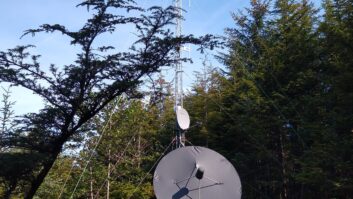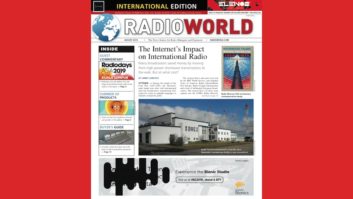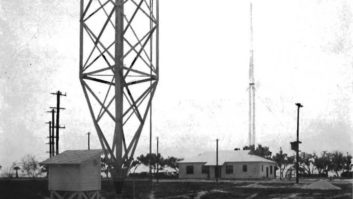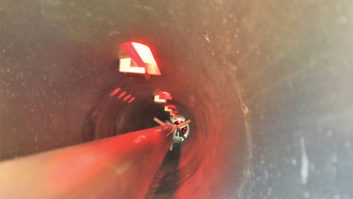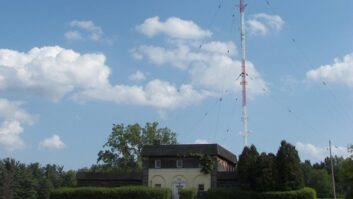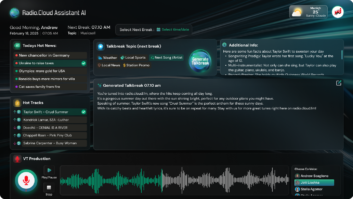The summer breeze brings a rise in temperature that can test equipment to its limits. As any on-call engineer knows, breakdowns sometimes come at the worst possible time. Air conditioners often fail at the peak of summer, when technicians are at their busiest attending to other customers who also have air conditioning issues.
One time, I was watching a replay of a basketball championship game at which the crowd changed “Beat the Heat” against the opposing team. Then a little later, I was in a place where there is neither game nor chanting. It was an emergency at the transmitter site, where the air conditioning system had broken down. That “Beat the Heat” chant seemed to have a whole new meaning.
As the temperature rose, the transmitter power modules were overheating. I needed to reduce the power, which at the time was not easy to do because of a problem with the exciter. I was finally able to reduce the power and prevent the overheating of the transmitter.
However, I sweated it out for one more day until we got a rental 20-ton A/C unit. This got our transmitter back to full power. (Yes, there are 20-ton air conditioners for rent — and they do the ductwork as well).
The building had two A/C units: a 10-ton and a 15-ton, for a total of 25 tons of total cooling capacity. With the 20-ton rental unit and the remaining 10-ton building unit, the total capacity increased to 30 tons, a little better than it normally was. But we still needed to find out the actual cooling capacity that was needed. This meant working with an air conditioning contractor.
DRAMA QUEEN
Among the transmitters of our TV network, this 15 kW DTV solid-state transmitter was the drama queen. There had been all kinds of failures since its installation in 2008. All 24 of the power modules had experienced some type of failure. The power supply also had seen failures, and there were a number of other issues throughout the years of use.
Then, as in a soap opera with a bad ending, the transmitter manufacturer went bankrupt.
In 2015, the transmitter site was assigned to me, and I had to dissect the cause of the problems one by one. One suspected cause of the failures was inadequate cooling inside the transmitter building. The 25-ton total cooling capacity was not enough because the flange temperature of the power transistors was on the high side and the surface-mounted capacitors on the pallets were burning up as well. The transmitter building originally had an analog klystron transmitter with the 10-ton A/C unit. The old transmitter was water-cooled while the solid-state was all air-cooled. They later added the 15-ton A/C unit.
In UHF, a solid-state transmitter is only about 18–22 percent efficient, needing a high airflow for cooling. Table 1 gives us a mental picture of how much higher the cooling and airflow requirement is for UHF compared to other devices of lower frequencies.

We can see that with comparable RF output of an FM transmitter, the UHF requires four times the airflow and more than ten times (an order of magnitude rise) in cooling capacity. Another consequence of high volume air-cooling is the noise level of the huge centrifugal fans.
CHOOSING THE A/C CONTRACTOR
Selecting the right contractor for a broadcast facility is crucial. Unfortunately, according to surveys, well over half of HVAC contractors do not size the cooling system correctly (which probably explains our problem). It is therefore important that we know how to get the right contractor and be knowledgeable enough on the subject matter as well.
A/C contractors have a rule of thumb when it comes to sizing air conditioners: Measure the floor area of the room; and from that, figure out the size of the air conditioner. This method does not work for transmitter buildings.
Then, as we know, there are stories going around about contractors. For example, some say scrupulous contractors would inflate the cooling load so that a bigger than necessary A/C unit would be installed.
According to Air Conditioning Contractors of America (ACCA), when sizing A/C units, contractors should be proficient in doing Manual J cooling load calculation and Manual S equipment selection. If your contractor is unfamiliar with these methods, you may need to look for another one.
MANUAL J LOAD CALCULATION
There are plenty of resources online on this topic. Software and apps make the calculations easier. The main thing is to make sure all heat loads are accounted for. There are two kinds of heat loads: sensible and latent heat loads. Sensible heat causes temperature rise inside the building (e.g. transmitter). On the other hand, latent heat is caused by the increase in the moisture content of the air inside the building (e.g. outside air infiltration in the building).
The intake-to-exhaust temperature difference and relative humidity are often overlooked in heat-producing equipment like a transmitter. To obtain these two values accurately, the measurements should be done during full-power testing at the factory. These measurements will help verify efficiency claims and will also help determine the amount of heat the transmitter blowers actually remove.
The sensible heat load equation is:

Air infiltration from outside brings both latent and sensible heat inside the building. If staff occupies the building, the human occupants also have latent and sensible heat loads. The total heat load is the sum of the sensible and latent heat: QT = QS+ QL.
During summer, a standalone building will receive solar radiation throughout the day. The east side will have peak radiation mid- to late-morning; the roof heat peaks at noon, and the west side peaks at mid-afternoon.
Then, if the walls are all made of concrete, the heat absorbed by the concrete will be released at night. For a given area of a concrete wall with length L and height H (both in feet), the heat equation is:

There are other possible sources of cooling load in a building; it is beyond the scope of this article to discuss all of them. However, we can look at a typical broadcast transmitter house as a sample problem.
A REAL-WORLD EXAMPLE
Let’s say we need an air conditioner for a new 30 kW FM transmitter. The cooling will not be supplemented with outside air. That is, all the cooling air is circulated inside the building (closed system).
The radiated solar heat on walls is calculated to be 35,000 BTU/hour while the rack equipment heat is 1,500 BTU/hour. Latent heat load amounts to 1,200 BTU/hour.

With 10.28 tons of cooling, the air conditioning system takes care of the entire heat load, even at the peak of summer. The transmitter manufacturer actually specified only 7.5 tons cooling capacity, but as we can see in this example, the required tonnage is much more than that.
In addition, when looking at the cooling capacity figures of the air conditioners, they specify the cooling in gross capacity. In actual application, net cooling capacity is used, not the gross cooling. Net cooling = Gross cooling – indoor blower heat.
From the cooling capacity table of a typical commercial unit, 10 tons would be inadequate, so we go to the next higher tonnage, which is 12.5 tons. A packaged-type cooling table would look something like Table 2.
With the extra cooling capacities on both sensible and latent, the 12.5 ton can meet the design condition of TR = 75° F, 50% RH and 95° F outdoor condition.
Manual S allows up to 15% overcapacity on TC. Ideally, a backup of the same size is also used. If there is no backup, an emergency exhaust system should probably be installed.
Selecting a properly-sized air conditioner is almost like an “imperfect” art because exact values cannot be obtained on each parameter. What is important is that the design conditions are met with some extra capacity, but not too much.
MIXED AIR AND EQUIPMENT SELECTION
Going back to the problem I began with in this article, tilt-up slabs of concrete 6.5 inches thick were used to construct the transmitter building. This was without insulation.
The exhaust air of the transmitter was ducted to the outside. This means that outside air was mixed with the supply air from the A/C, and this mixed air has a temperature somewhere in between the outside air temperature and the A/C supply air temperature. The incoming air also brings both latent and sensible heat. This kind of setup is called mixed air in the A/C contractor parlance.
When we were doing the calculations for the total heat load, it turned out that using mixed air was not the best setup for the high airflow rate that the transmitter requires. There are two main reasons:
First, a closed-loop (no outside air) would actually need a lower capacity A/C than the mixed air setup. Secondly, the summer latent heat from the outside air is very high. This is due to the high airflow requirement from the transmitter.
Humidity control becomes an issue with high latent loads. However, closed-loop means a very costly rework of the room infrastructure. We therefore decided not to change the physical set-up and concentrate on the A/C replacement only. Actually, commercial A/C installations very often use mixed air in their designs, but not at this much airflow of outside air.
The irony of mixed air is that “heat” from outside air was used to remove heat from inside the room.
At any rate, we decided to add a new 25-ton packaged air conditioner, and the total cooling capacity added up to 35 tons. A backup 25-ton unit was also considered. We chose the Rheem brand because we have good experience with their product. The new Rheem 25-ton unit was installed in August 2015. The building temperature and the power transistors flange temperature improved to an acceptable level.
As a broadcast engineer, you do not have to dread the summer heat when the cooling system is designed properly. All possible sources of heat need to be considered when doing heat load calculation; then use those figures to select the proper type and size of cooling equipment. Last, a competent contractor is crucial to the success of any project.






